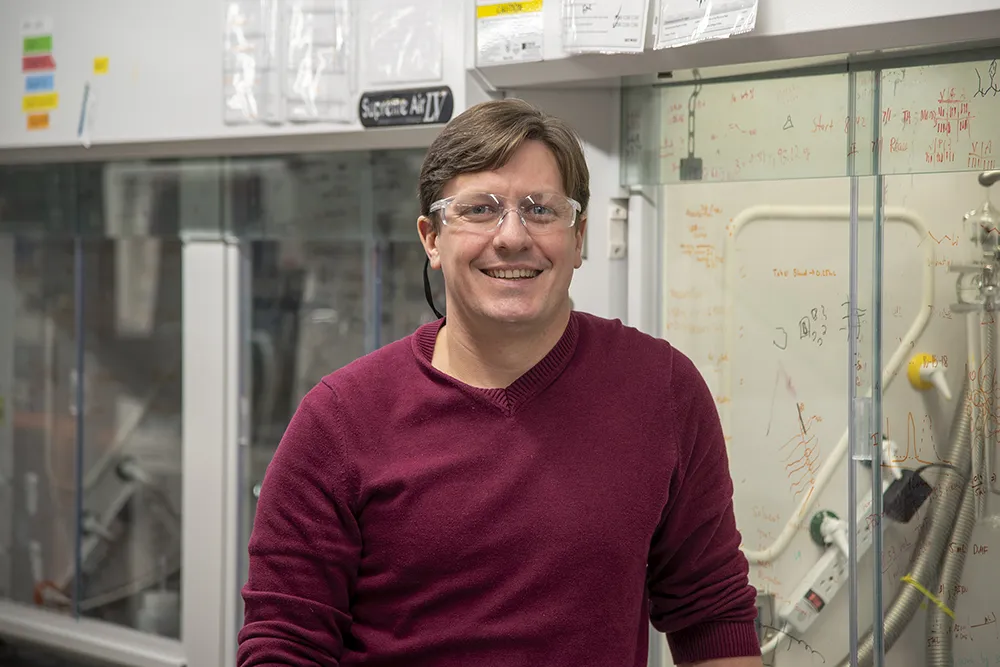High-performance ceramics that can withstand extreme temperatures of thousands of degrees Celsius and rapid changes in temperature without degradation enable hypersonic vehicles in aerospace and defense applications, but current technologies limit their production. A new approach, led by Penn State researchers, using laser processing may help produce these materials at lower temperatures, potentially enabling fabrication via 3D printing.
Robert Hickey, associate professor of materials science and engineering at Penn State, and Michael Hickner, a professor at Michigan State University, will lead the team, which has been awarded a five-year, $4.5 million Multidisciplinary University Research Initiative grant by the U.S. Department of Defense (DoD), through the Office of Naval Research (ONR).
The project, titled “Photochemical and Photothermal Additive Manufacturing of Preceramic Polymers,” seeks to create a one-step process to produce ultra-high-temperature ceramic materials without bulk heating. The team is focusing on the potential of using light to convert polymer precursor molecules — starting materials that are easy to process — into the final ceramic product.
Problem Solving Using: High-performance Ceramics
“The big problem currently in forming ceramics is the high temperatures and high energy required,” Hickey said. “That has been a detriment, especially for 3D printing, which is currently very hard to do precisely with these materials.”
Converting polymer precursors to ceramics currently involves heating the materials in bulk to high temperatures — a process that can lose as much as 50% of the precursor material. The process can also change the geometry of the finished ceramic parts, contributing to the trickiness of precise 3D printing, Hickey said.
Using high-intensity lasers, the scientists estimate that they can produce chemical reactions in the precursor materials that will allow them to rapidly densify into hardened ceramic materials without bulk heating. This would enable rapid, high-fidelity 3D printing, the researchers said, because heating materials with light leads to faster processing than traditional thermal methods.
“There’s a major need to try to reduce the energy necessary to convert or make these ceramics and to prevent major geometry changes after printing and processing,” Hickey said. “So, really, we are looking at how to convert polymers into ceramics using light with the ultimate goal of 3D printing high-performance ceramics.”
In addition to Penn State and Michigan State, the team also includes researchers at the Massachusetts Institute of Technology (MIT) and the University of Southern California (USC).
The MURI program involves teams of researchers investigating high-priority topics and opportunities that intersect more than one traditional technical discipline. For many military problems, this multidisciplinary approach serves to stimulate innovations, accelerate research progress and expedite transition of results into naval applications, according to the ONR website.
“This project funding is critical to bring together a world-class team with partners that have unique skills and that have displayed outstanding results in their individual programs and through existing and previous collaborations, including Penn State with our decades-long traditions in ceramic science and materials chemistry and our long history of participating in DoD-focused research,” said Benjamin Lear, professor of chemistry at Penn State and a co-principal investigator (PI) on the project. “Penn State, Michigan State, MIT and USC are ideal partners in this work and already have existing ties between computational and experimental researchers on this team.”
The project will involve synthesizing novel precursors, exploring different ways to promote light-based ceramic conversion, gaining computational insights into the reaction conversion pathways and feeding the insights back to precursor design and synthesis, the researchers said.
“It’s a combination of experiment and simulation theory,” Hickey said. “We will feed our initial results into our simulations, which can then predict new polymer precursors that will provide even better results. And so, this feedback loop where we’re being informed by theory and simulation will help us to redesign new polymer materials. Simulation can also point the way towards chemistries that we haven’t considered experimentally.”
The findings could have future DoD impacts in the area of advanced hypersonic vehicles, the scientists said. The ability to additively form ceramic materials that can perform at ultra-high temperatures into new shapes significantly opens the design window for advanced re-entry vehicles.
“This program will open new avenues to additive manufacturing ceramic materials across a number of high-temperature metal carbides, such as tungsten carbide, and silicon-based ceramics, such as silicon carbide and silicon nitride,” said Adri van Duin, Penn State distinguished professor of mechanical engineering and a co-PI. “Additionally, new computational capability will be built to predict high-energy reaction intermediates, which will be used to design new precursors and processing regimes.”
Also contributing from Penn State is Jon-Paul Maria, professor of materials science and engineering.
Priya Vashishta, professor of chemical engineering and materials science, and Aiichiro Nakano, professor of computer science, at the University of Southern California and Alexander Radosevich, professor chemistry at the MIT, are co-PIs on the project.

